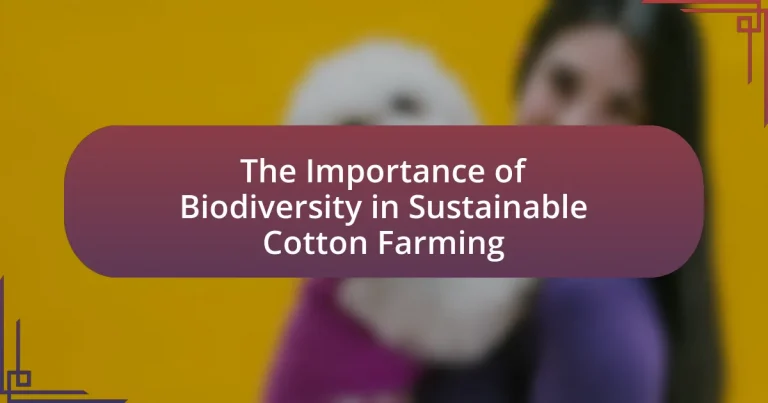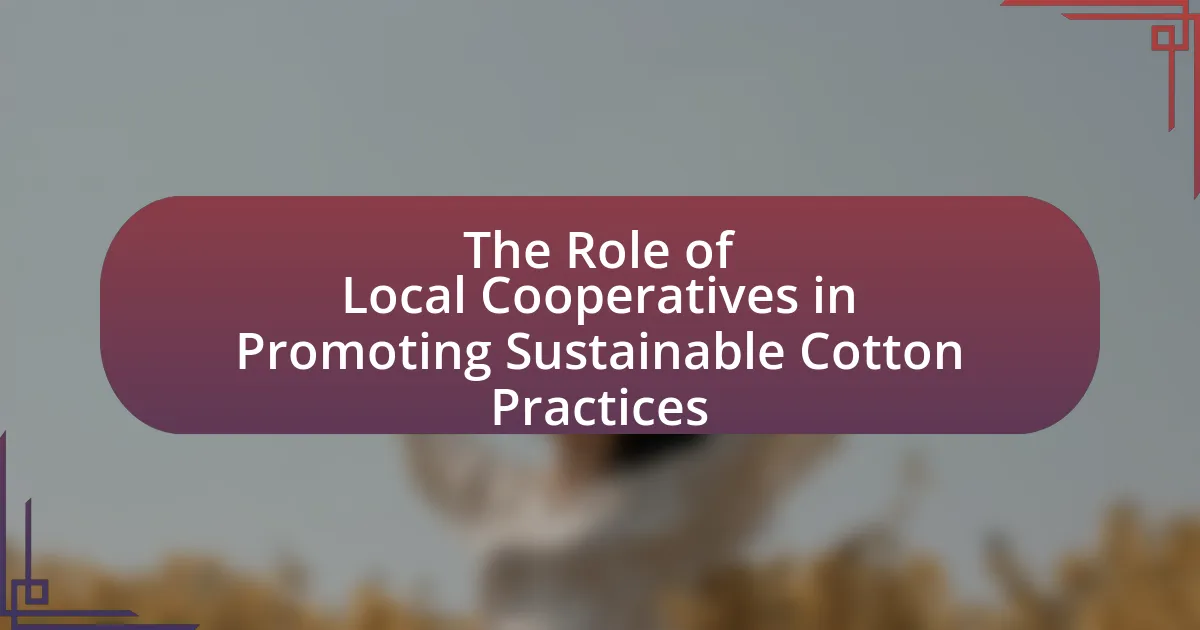Biodiversity is a critical component of sustainable cotton farming, significantly enhancing ecosystem resilience, soil health, and pest management. The article explores how diverse plant and animal species contribute to a balanced ecosystem that can better withstand environmental stressors, leading to improved agricultural productivity. It highlights the role of biodiversity in soil health, pest control, and water conservation, while also addressing the challenges posed by monoculture practices and pesticide use. Sustainable practices such as crop rotation, intercropping, and organic farming are emphasized as effective strategies to promote biodiversity and ensure the long-term viability of cotton farming.
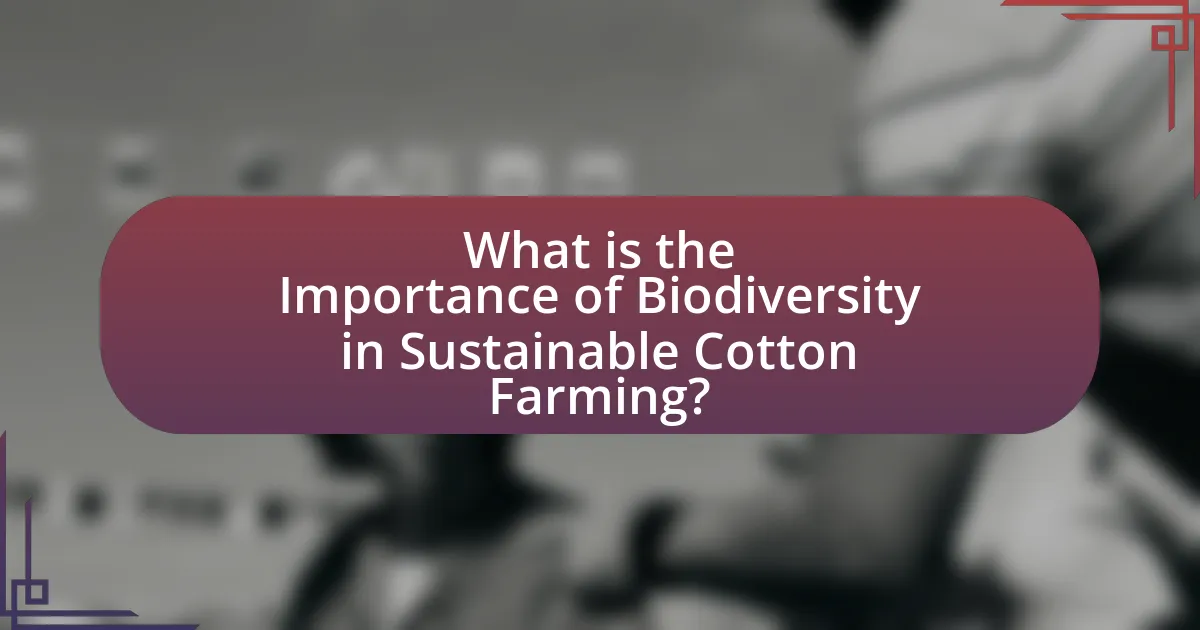
What is the Importance of Biodiversity in Sustainable Cotton Farming?
Biodiversity is crucial in sustainable cotton farming as it enhances ecosystem resilience, improves soil health, and supports pest management. Diverse plant and animal species contribute to a balanced ecosystem, which can better withstand environmental stressors such as climate change and disease. For instance, a study published in the journal “Agriculture, Ecosystems & Environment” found that farms with higher biodiversity levels experienced reduced pest outbreaks, leading to lower pesticide use and healthier cotton crops. Additionally, diverse microbial communities in the soil improve nutrient cycling and enhance soil structure, which is vital for cotton growth. Therefore, promoting biodiversity in cotton farming not only supports environmental sustainability but also boosts agricultural productivity.
Why is biodiversity crucial for sustainable agriculture?
Biodiversity is crucial for sustainable agriculture because it enhances ecosystem resilience, improves soil health, and supports pest control. Diverse plant and animal species contribute to a balanced ecosystem, which can better withstand environmental stresses such as climate change and disease outbreaks. For instance, a study published in the journal “Nature” found that farms with higher biodiversity had 20% greater crop yields compared to monoculture systems, demonstrating the direct benefits of diverse agricultural practices. Additionally, biodiversity fosters beneficial interactions among species, such as pollination and natural pest management, which are essential for maintaining productivity in sustainable cotton farming.
What role does biodiversity play in soil health?
Biodiversity plays a crucial role in soil health by enhancing soil structure, fertility, and resilience. Diverse organisms, including bacteria, fungi, and invertebrates, contribute to nutrient cycling, organic matter decomposition, and the formation of soil aggregates, which improve aeration and water retention. Research indicates that soils with higher biodiversity exhibit increased microbial activity and nutrient availability, leading to healthier plant growth. For instance, a study published in the journal “Nature” found that diverse soil communities can increase crop yields by up to 20% due to improved nutrient uptake and disease resistance.
How does biodiversity contribute to pest management?
Biodiversity contributes to pest management by enhancing ecosystem resilience and promoting natural pest control mechanisms. Diverse ecosystems support a variety of predators and parasitoids that can effectively regulate pest populations. For instance, studies have shown that fields with higher plant diversity attract beneficial insects, which can reduce pest outbreaks by up to 50%. This natural pest control reduces the reliance on chemical pesticides, promoting sustainable farming practices.
What are the ecological benefits of biodiversity in cotton farming?
Biodiversity in cotton farming enhances ecosystem resilience, improves soil health, and promotes pest control. Diverse plant and animal species contribute to a balanced ecosystem, which can better withstand environmental stressors such as drought and disease. For instance, studies show that farms with higher biodiversity levels experience reduced pest outbreaks, as natural predators thrive in diverse habitats, leading to lower reliance on chemical pesticides. Additionally, diverse root systems from various plants improve soil structure and nutrient cycling, which enhances soil fertility and reduces erosion. Research indicates that cotton farms with integrated biodiversity practices can yield up to 20% more cotton while using fewer resources, demonstrating the ecological advantages of maintaining biodiversity in agricultural systems.
How does biodiversity enhance ecosystem resilience?
Biodiversity enhances ecosystem resilience by increasing the variety of species and genetic diversity within an ecosystem, which allows it to better withstand environmental changes and disturbances. Diverse ecosystems are more capable of recovering from stressors such as climate change, pests, and diseases because they contain a wider range of functional traits and interactions among species. For instance, a study published in the journal “Nature” found that ecosystems with higher biodiversity can recover more quickly from disturbances, demonstrating that species richness contributes to stability and resilience. This adaptability is crucial in sustainable cotton farming, where diverse plant and animal species can improve soil health, pest control, and overall crop productivity.
What impact does biodiversity have on water conservation?
Biodiversity significantly enhances water conservation by maintaining ecosystem functions that regulate water cycles. Diverse plant and animal species contribute to soil health, which improves water retention and reduces runoff. For instance, studies show that ecosystems with higher biodiversity can retain up to 30% more water compared to monocultures, as diverse root systems create better soil structure and increase infiltration rates. Additionally, biodiversity supports the presence of various organisms that help filter and purify water, further promoting sustainable water management in agricultural practices like cotton farming.
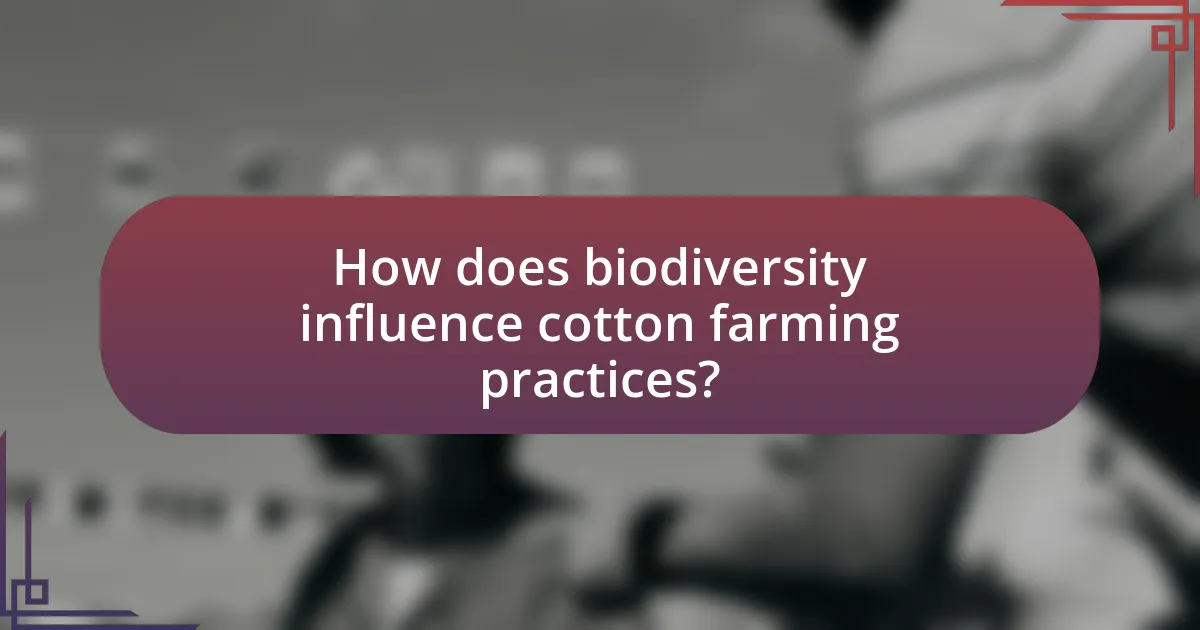
How does biodiversity influence cotton farming practices?
Biodiversity significantly influences cotton farming practices by enhancing ecosystem resilience and promoting natural pest control. Diverse ecosystems support a variety of organisms, including beneficial insects and microorganisms, which can reduce the reliance on chemical pesticides. For instance, studies have shown that farms with higher biodiversity levels experience lower pest populations, leading to improved cotton yields and reduced input costs. Additionally, diverse plant species can improve soil health and fertility, which are crucial for sustainable cotton production. Research indicates that integrating cover crops and crop rotations can enhance soil biodiversity, further supporting sustainable farming practices.
What sustainable practices promote biodiversity in cotton farming?
Sustainable practices that promote biodiversity in cotton farming include crop rotation, intercropping, and organic farming methods. Crop rotation enhances soil health and reduces pest populations by alternating cotton with other crops, which disrupts pest life cycles. Intercropping, the practice of growing different crops in proximity, increases habitat diversity and attracts beneficial insects that can control pests naturally. Organic farming methods, which avoid synthetic pesticides and fertilizers, foster a healthier ecosystem by promoting soil biodiversity and enhancing the resilience of cotton crops against diseases. These practices collectively contribute to a more balanced ecosystem, supporting various species and improving overall agricultural sustainability.
How can crop rotation enhance biodiversity?
Crop rotation enhances biodiversity by promoting a diverse range of plant species and improving soil health. This agricultural practice reduces the dominance of any single crop, which can lead to pest and disease outbreaks, while encouraging beneficial organisms and natural predators. Research indicates that diverse cropping systems can increase the abundance and diversity of soil microorganisms, which play a crucial role in nutrient cycling and ecosystem resilience. For instance, a study published in the journal “Agriculture, Ecosystems & Environment” found that crop rotation significantly increased the diversity of soil microbial communities compared to monoculture systems, thereby supporting overall ecosystem health and productivity.
What is the role of cover crops in supporting biodiversity?
Cover crops play a crucial role in supporting biodiversity by providing habitat and food sources for various organisms, including beneficial insects, birds, and soil microorganisms. These crops enhance soil health and structure, which in turn fosters a diverse ecosystem. Research indicates that cover crops can increase the abundance and diversity of soil fauna, which contributes to nutrient cycling and pest control. For instance, a study published in the journal “Agriculture, Ecosystems & Environment” found that fields with cover crops had significantly higher levels of earthworm populations, which are vital for soil aeration and organic matter decomposition. This biodiversity not only supports ecological balance but also improves the resilience of agricultural systems, particularly in sustainable cotton farming.
How do farmers measure biodiversity in their cotton fields?
Farmers measure biodiversity in their cotton fields primarily through species richness assessments, which involve counting the number of different species present in a given area. This method allows farmers to evaluate the variety of plants, insects, and microorganisms that contribute to the ecosystem’s health. Additionally, farmers may use indices such as the Shannon-Wiener index to quantify biodiversity, providing a numerical value that reflects both species richness and evenness. Research indicates that higher biodiversity can lead to improved pest control and pollination, ultimately enhancing cotton yield and sustainability.
What indicators are used to assess biodiversity levels?
Indicators used to assess biodiversity levels include species richness, species evenness, and the presence of indicator species. Species richness measures the number of different species in a given area, while species evenness evaluates how evenly individuals are distributed among those species. The presence of indicator species, which are sensitive to environmental changes, can provide insights into the health of an ecosystem. These indicators are widely recognized in ecological studies, such as the Global Biodiversity Assessment, which emphasizes their role in understanding biodiversity and ecosystem health.
How can technology aid in monitoring biodiversity?
Technology aids in monitoring biodiversity through the use of remote sensing, data analytics, and citizen science platforms. Remote sensing technologies, such as satellite imagery and drones, enable researchers to collect large-scale environmental data, allowing for the assessment of habitat changes and species distribution. For instance, satellite data can track deforestation rates and land-use changes that impact biodiversity. Data analytics tools process this information to identify trends and patterns in biodiversity loss or gain, facilitating informed conservation strategies. Additionally, citizen science platforms engage the public in biodiversity monitoring, enabling the collection of species data from diverse locations, which enhances the overall understanding of biodiversity dynamics. These technological advancements collectively provide accurate, real-time insights into biodiversity, essential for sustainable practices in agriculture, including cotton farming.
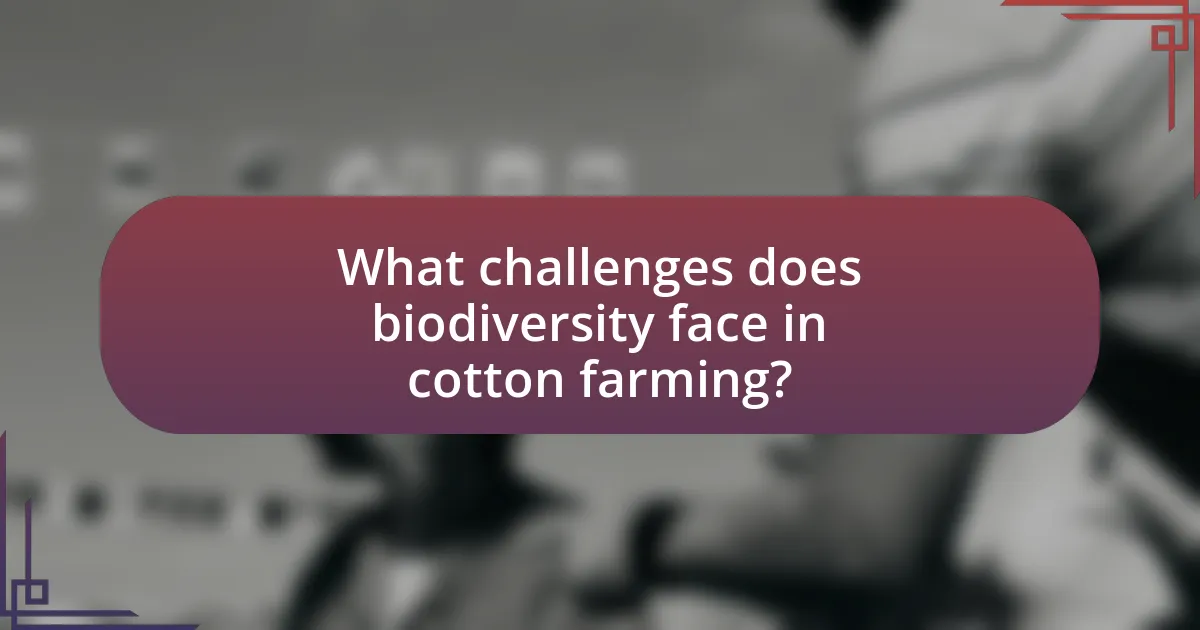
What challenges does biodiversity face in cotton farming?
Biodiversity in cotton farming faces significant challenges primarily due to monoculture practices, pesticide use, and habitat destruction. Monoculture, the cultivation of a single crop over a wide area, reduces genetic diversity and makes ecosystems more vulnerable to pests and diseases. The extensive use of pesticides in cotton farming not only targets harmful insects but also adversely affects non-target species, including beneficial pollinators and soil organisms, leading to a decline in overall biodiversity. Additionally, habitat destruction caused by land conversion for cotton cultivation further diminishes the natural habitats of various species, disrupting ecosystems and reducing their resilience. These factors collectively threaten the sustainability of cotton farming and the ecosystems it relies on.
What are the main threats to biodiversity in cotton agriculture?
The main threats to biodiversity in cotton agriculture include pesticide use, monoculture practices, and habitat destruction. Pesticide use can lead to the decline of non-target species, including beneficial insects and pollinators, which are crucial for ecosystem balance. Monoculture practices reduce genetic diversity and make crops more susceptible to pests and diseases, further threatening biodiversity. Habitat destruction occurs when land is cleared for cotton cultivation, leading to loss of native flora and fauna. According to the Food and Agriculture Organization, these factors collectively contribute to significant biodiversity loss in agricultural landscapes, emphasizing the need for sustainable practices in cotton farming.
How does monoculture affect biodiversity?
Monoculture negatively affects biodiversity by reducing the variety of species in an ecosystem. This agricultural practice involves cultivating a single crop over a large area, which leads to habitat loss for various organisms and diminishes genetic diversity. For instance, studies have shown that fields dominated by monoculture crops, such as cotton, support fewer insect species and other wildlife compared to polyculture systems. Research published in the journal “Biodiversity and Conservation” indicates that monoculture can decrease species richness by up to 50% in agricultural landscapes. This loss of biodiversity can disrupt ecosystem services, such as pollination and pest control, ultimately impacting agricultural sustainability.
What impact do pesticides have on biodiversity?
Pesticides significantly reduce biodiversity by harming non-target species, disrupting ecosystems, and leading to declines in populations of beneficial organisms. For instance, studies have shown that pesticide application can decrease the abundance and diversity of pollinators, such as bees, which are crucial for crop pollination and ecosystem health. Research published in the journal “Nature” indicates that neonicotinoids, a class of pesticides, have been linked to a 30% decline in bee populations in agricultural areas. Additionally, pesticides can contaminate soil and water, further affecting aquatic and terrestrial organisms, thereby diminishing overall biodiversity.
How can farmers overcome challenges to maintain biodiversity?
Farmers can overcome challenges to maintain biodiversity by implementing sustainable agricultural practices such as crop rotation, intercropping, and organic farming. These methods enhance soil health, reduce pest populations, and promote a diverse ecosystem. For instance, crop rotation prevents soil depletion and encourages a variety of plant species, which supports beneficial insects and microorganisms. Research indicates that farms practicing diverse cropping systems can increase biodiversity by up to 30% compared to monoculture systems. Additionally, integrating native plants into farming landscapes can provide habitats for wildlife, further supporting biodiversity.
What strategies can be implemented to enhance biodiversity?
To enhance biodiversity in sustainable cotton farming, implementing crop rotation is essential. Crop rotation involves alternating the types of crops grown in a particular area over time, which helps to improve soil health, reduce pest populations, and promote a diverse ecosystem. Research indicates that diverse cropping systems can increase the abundance and variety of beneficial organisms, such as pollinators and natural pest predators, thereby enhancing overall biodiversity. Additionally, integrating cover crops can further support soil biodiversity by providing habitat and food sources for various organisms, contributing to a more resilient agricultural system.
What best practices can farmers adopt for promoting biodiversity in cotton farming?
Farmers can promote biodiversity in cotton farming by implementing crop rotation, intercropping, and organic farming practices. Crop rotation helps maintain soil health and disrupts pest cycles, while intercropping introduces diverse plant species that can enhance ecosystem resilience. Organic farming reduces chemical inputs, fostering a healthier environment for beneficial organisms. Research indicates that diverse cropping systems can increase yields by up to 20% compared to monocultures, demonstrating the effectiveness of these practices in enhancing biodiversity and sustainability in cotton farming.
